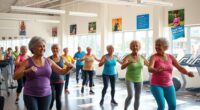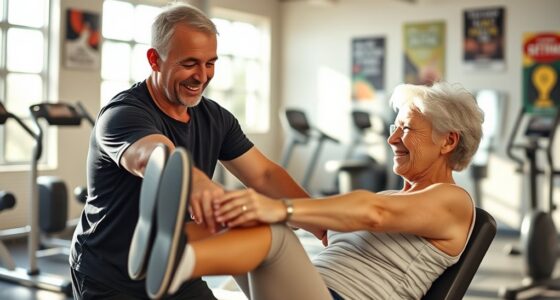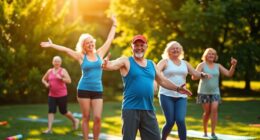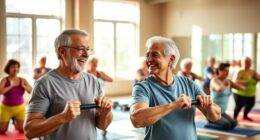Walking workouts are a fantastic way for seniors to boost their health and well-being. They offer low-impact exercise that strengthens the heart and improves mood while promoting mobility and balance. Start with gentle warm-ups like marching in place, then enjoy engaging activities, and always cool down after. Consistent routines enhance benefits and boost social bonds. Plus, you can make your walks enjoyable by exploring scenic areas or joining friends. Discover more tips to enhance your walking experience!
Key Takeaways
- Incorporate effective warm-up techniques to prepare your body and prevent injuries before starting your walking routine.
- Engage in simple movements like marching in place to enhance core strength, balance, and coordination during your walks.
- Cool down with stretching exercises post-walk to promote recovery and maintain flexibility in your muscles.
- Join a walking group to foster social interaction, boost motivation, and enhance mental health while exercising.
- Set achievable walking goals and track your progress to maintain consistency and celebrate your fitness milestones.
Benefits of Walking for Seniors
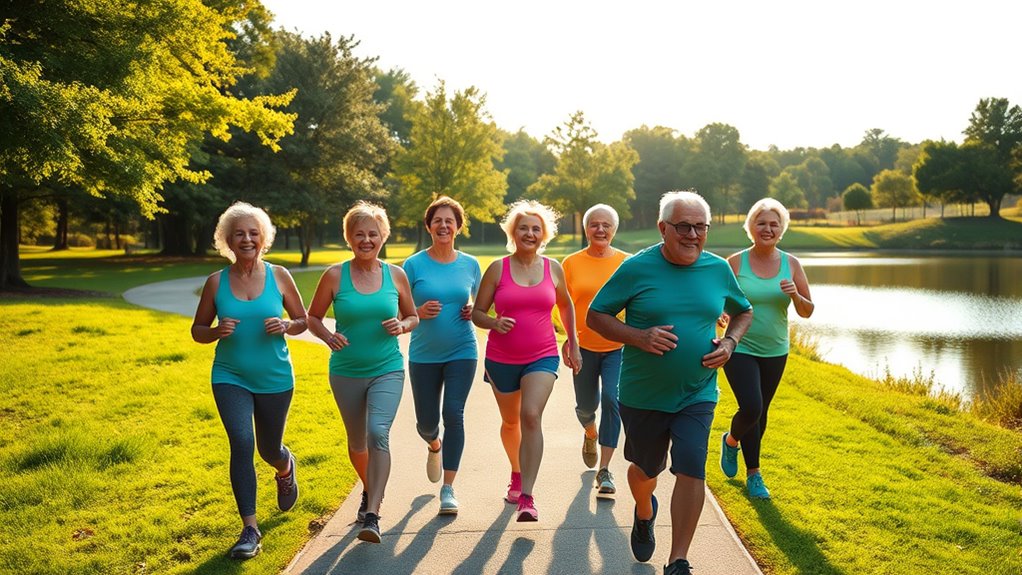
Walking offers seniors a simple yet effective way to stay active and healthy. This low-impact exercise is gentle on your joints, making it sustainable without causing strain or injury. Additionally, adopting nail styles that reflect your personal style can enhance the overall sense of well-being and self-care. Regular walking boosts your heart rate, enhancing cardiovascular health and reducing the risk of heart disease, which is crucial for maintaining overall wellness. Plus, it promotes mobility and strength, helping you maintain independence and greatly help prevent falls. Furthermore, engaging in regular walking is especially important for user privacy, as it encourages a balanced lifestyle that can lead to better mental and physical health. Walking also embodies the spirit of love and compassion, which can uplift one’s emotional well-being and foster a sense of community.
Engaging in walking also has mental health benefits; studies show it can boost cognitive function and improve mood. Health professionals often recommend daily walks for seniors due to these numerous benefits, including enhanced longevity and overall quality of life. Additionally, incorporating walking into your routine can help reset, recover, and restart life by providing a structured activity that promotes stability and well-being.
Effective Warm-Up Techniques

Before you start your walking workout, warming up is essential to prepare your body and prevent injury. Engaging your core and adjusting the pace to fit your fitness level can enhance your warm-up experience. Let’s explore effective techniques to get you moving safely and confidently. Incorporating hydration strategies into your routine can also help maintain optimal performance during your workout. Additionally, warming up can improve your overall image quality by preparing your muscles for more intense activity. Regular maintenance of your body, similar to how heat pumps require routine care to maximize efficiency, can also lead to improved performance and longer-lasting health benefits. Be sure to consider the energy-saving features of your workout routine, as they can significantly enhance your overall effectiveness. Consider adding stainless steel tube smokers to your grilling setup, as they provide a flavorful way to enhance your post-workout meals.
Importance of Warm-Ups
Warm-ups are vital because they prepare your body for exercise and help prevent injuries. Engaging in effective warm-ups, like marching in place and side steps, gradually increases your heart rate and enhances circulation. Additionally, incorporating breathing exercises can support air quality considerations by promoting oxygen flow to your muscles. Moreover, using essential oils for aromatherapy during your warm-up can enhance your relaxation and focus, creating a more effective exercise routine. Including hydration with fresh juices can also boost your energy levels during your workout.
To improve stability and reduce injury risk, focus on maintaining proper posture while you warm up. Incorporating arm movements can activate upper body muscles and promote coordination, contributing to a thorough warm-up. Practicing these warm-up techniques can align with high vibrational energy principles that enhance your overall workout experience.
Remember, individual pacing is significant—adjust the intensity based on your fitness level for a safe start. A well-structured warm-up routine not only enhances flexibility and range of motion but also boosts your overall workout performance, leading to better outcomes during your main exercise session. Additionally, being aware of filial responsibility laws can help ensure that financial planning for your health needs is addressed proactively.
Engaging Core Muscles
Engaging your core muscles during warm-up exercises can greatly enhance your balance and stability, which is essential for preventing falls as you age. Simple movements like marching in place and side steps not only activate your core but also improve overall body coordination. Maintaining good posture—shoulders back and head up—promotes proper core engagement and alignment. Additionally, incorporating warm-up techniques can help mitigate feelings of helplessness during sleep that some seniors may experience, fostering a greater sense of control in their daily lives. Regular physical activity, including effective relaxation techniques, can further support overall well-being.
Here’s a quick table of effective warm-up exercises that engage your core:
| Exercise | Benefits |
|---|---|
| Marching in Place | Activates core, improves balance |
| Side Steps | Enhances coordination |
| Arm Circles | Challenges core, strengthens |
| Torso Twists | Increases flexibility |
Incorporating these techniques into your routine sets a strong foundation for a safer and more effective workout session.
Individual Pacing Strategies
As you prepare for your walking workout, it’s important to pace yourself according to your individual fitness level. Start with marching in place to elevate your heart rate while keeping good posture and engaging your core. Regular fuel injection cleaning can enhance your vehicle’s performance, just as warming up prepares your body for a better workout. During this time, it’s beneficial to remember that newborn sleep patterns can vary widely, just like how individual fitness levels differ among seniors. Awareness of these tiny pitfalls can enhance your personal growth and fitness journey. For instance, understanding the average time to build a tiny house can illustrate the importance of patience and gradual progress in achieving your fitness goals.
You can then incorporate side steps to activate your lateral muscles, which helps improve your overall balance and coordination. Don’t forget to add arm movements to enhance coordination and prepare your upper body.
Remember, individual pacing is key—adjust the intensity of your movements based on what feels comfortable for you.
Finally, conclude your warm-up with deep breathing to promote relaxation and get your body ready for the main workout. This approach will help you stay strong throughout your exercise routine. Additionally, incorporating seasonal themes into your walking routine can keep you motivated and engaged with your fitness journey.
Engaging Main Workout Activities
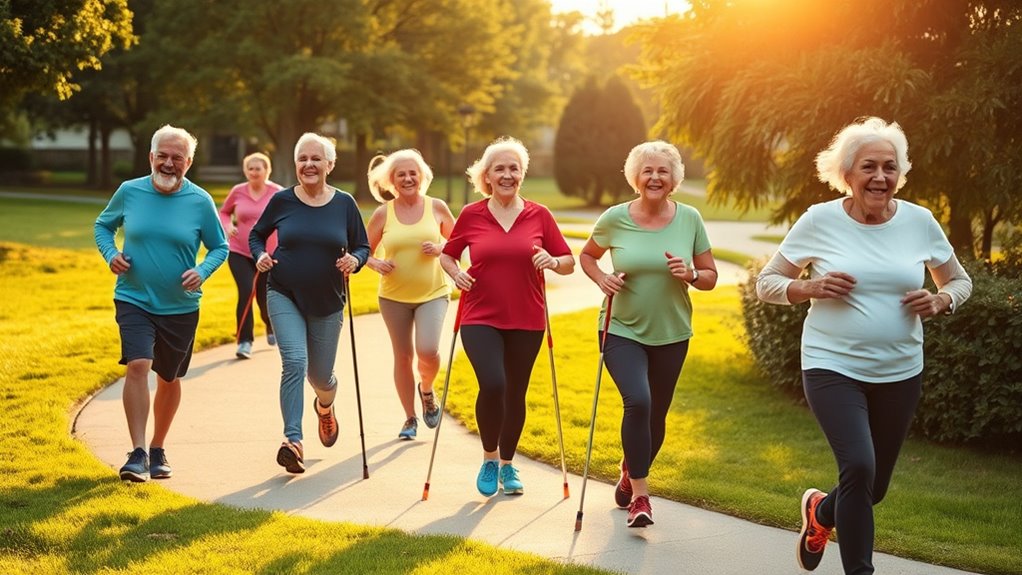
A variety of engaging main workout activities can make walking workouts for seniors both effective and enjoyable.
Start by incorporating heel touches forward to enhance your balance and coordination, which helps prevent falls. Regular physical activity is also a key factor in preventing falls among seniors.
While you’re marching in place, add bicep curls to boost your upper body strength and cardiovascular health simultaneously.
Engage your core with knee-ups to promote abdominal strength and improve your weight shifting capabilities.
Don’t forget to include out and in movements to strengthen your posterior chain muscles, supporting better posture and mobility.
Finally, challenge your coordination by walking forward and backward, stimulating brain activity and maintaining mental sharpness.
Additionally, staying hydrated during your workouts is crucial for overall health and can help prevent dehydration symptoms that may arise from physical exertion.
These activities will keep your workouts dynamic and beneficial for both your body and mind.
Cool Down and Recovery Strategies
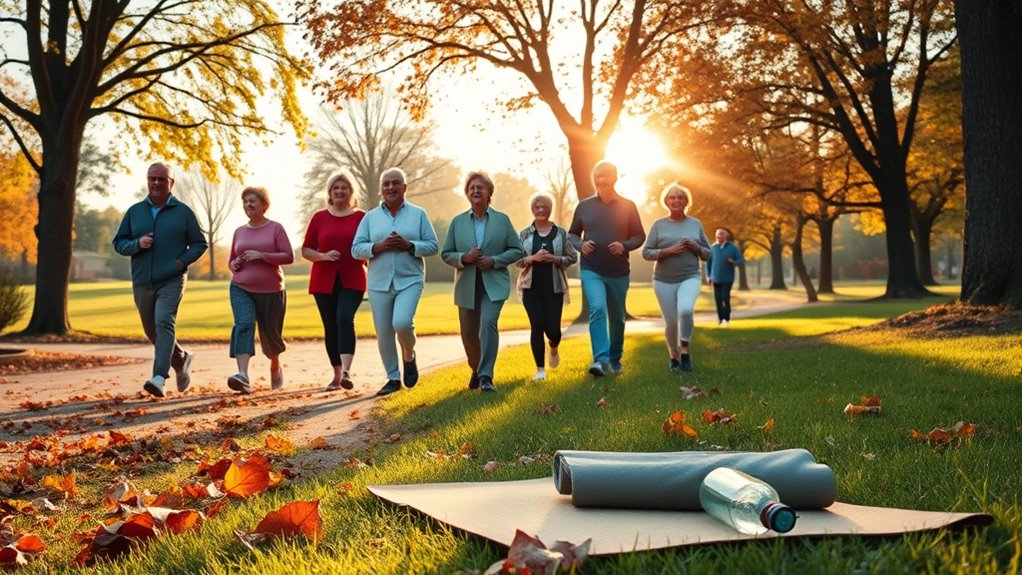
Cooling down after your walking workout is essential, not only for your heart rate but also for your overall recovery. Gradually lowering your heart rate helps prevent dizziness or fainting.
Incorporating stretching exercises during this time enhances flexibility and promotes muscle recovery, which is especially important for seniors. Focus on stretching your legs with forward bends and calf stretches to maintain proper alignment and alleviate muscle tension.
Additionally, practice deep breathing techniques, like up and down breathing, to aid in relaxation and guarantee effective recovery post-exercise.
Staying Consistent With Your Routine
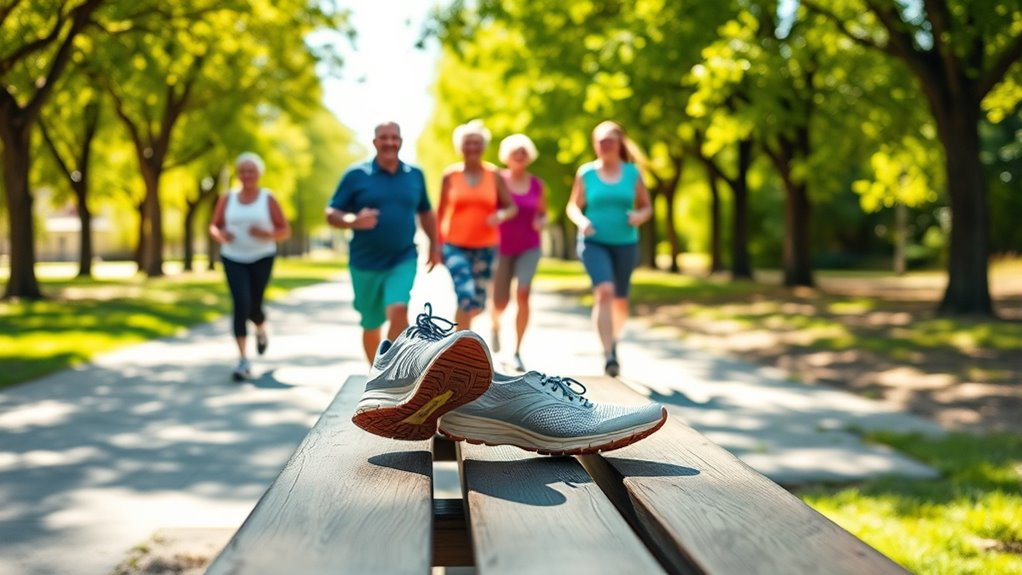
After you’ve completed your cooldown routine, staying consistent with your walking workouts is key to reaping the benefits of your efforts.
To help you maintain a steady routine, consider these tips:
- Set Achievable Goals: Start with small, manageable targets, like walking for just 10 minutes daily. A good job in achieving these will boost your motivation.
- Track Your Progress: Keeping a journal or using a fitness app can help you see how far you’ve come, reinforcing your commitment to staying consistent.
- Mix It Up: Incorporate different walking routes or add light stretches and strength exercises to keep things interesting.
Enhancing Social Interaction Through Exercise
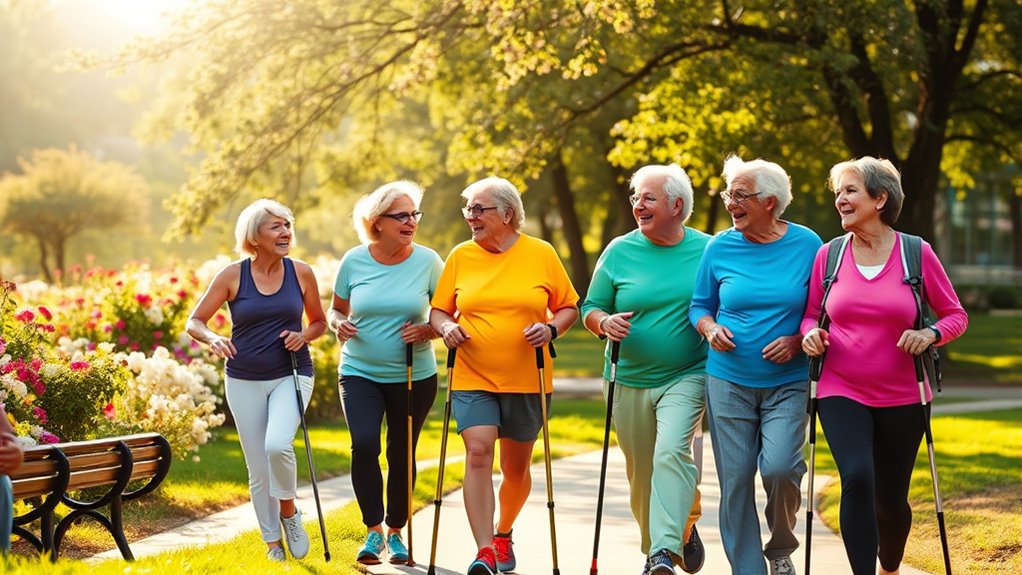
While walking can be a great way to stay fit, it also offers a fantastic opportunity to enhance your social life. Engaging in group exercises, like walking with others, fosters social interaction that helps you build friendships and combat feelings of isolation.
This connection can improve your mental health and boost your motivation. Studies show seniors participating in group workouts report higher satisfaction levels, thanks to the support and camaraderie they share.
Walking in pairs or groups encourages conversation, which enhances cognitive function and helps reduce cognitive decline. Plus, shared experiences—like discussing health tips or personal goals—strengthen community bonds and increase your commitment to fitness.
Tips for Making Walking Workouts Enjoyable

To make your walking workouts more enjoyable, choose fun and scenic locations that inspire you.
Incorporating social elements, like inviting a friend to join you, can boost motivation and make the experience more enjoyable.
Don’t forget to add music to your routine; it can lift your spirits and keep you moving!
Choose Fun Locations
Choosing fun locations for your walking workouts can make all the difference in staying motivated and enjoying the experience.
When you explore different environments, you’re more likely to look forward to each session. Here are some ideas to help you move around in enjoyable settings:
- Scenic Parks: Enjoy beautiful views and a calming atmosphere while walking through nature.
- Botanical Gardens: Experience vibrant flowers and plants that keep your routine fresh and engaging.
- Indoor Spaces: When the weather’s not cooperating, malls or community centers offer safe and controlled environments.
Incorporate Social Elements
Incorporating social elements into your walking workouts can transform them from a solitary task into an enjoyable group activity. Joining walking groups enhances social interaction, boosts motivation, and fosters accountability.
You’re more likely to stick with your routine when you walk with friends or family. Consider organizing walking challenges; a little friendly competition can make your workouts more engaging and fun.
Themed walks, like nature explorations or historical tours, can also add excitement. After your walk, plan a post-walk gathering, such as a picnic or coffee meet-up, to celebrate your achievements together.
These social elements not only make walking workouts more enjoyable but also encourage you to maintain a consistent routine.
Add Music Motivation
Adding music to your walking workouts can elevate the experience, making it more enjoyable and motivating.
Music motivation can help increase your endurance and overall workout satisfaction. Here are three tips to incorporate music effectively:
- Create Playlists: Mix your favorite songs with upbeat tracks to keep your energy high and make longer walks feel easier.
- Choose the Right Tempo: Select songs with a consistent rhythm to help synchronize your steps, promoting a smoother walking experience.
- Group Walks: Engage in walking sessions with friends while listening to music. This fosters community and camaraderie, making it more likely you’ll stick to your routine.
With these strategies, you’ll find walking workouts not only healthier but also a lot more fun!
Frequently Asked Questions
What Is a Good Walking Program for Seniors?
A good walking program for you includes daily sessions of at least 30 minutes.
Start with warm-ups like marching in place and side steps to prepare your body.
Mix in varied exercises, such as forward and backward steps and knee lifts, to improve your balance and strength.
Don’t forget a cooldown period with stretching and deep breathing to help you recover.
This routine can boost your mood and overall health considerably!
Is the 28 Day Indoor Walking Challenge Free?
You might think fitness programs always come with a hefty price tag, but the 28 Day Indoor Walking Challenge is actually free!
This accessible program lets you join online, making it easy to fit into your schedule. You’ll receive daily reminders and support to keep you motivated, ensuring you stay on track.
What’s the Best Exercise for a 70 Year Old?
The best exercise for a 70-year-old is often walking. It’s low-impact, easy on your joints, and great for your heart.
Just 10 minutes a day can make a difference, improving your mood and cognitive function. You’ll find it helps with mobility and independence, too.
Plus, staying active can aid in weight management and boost muscle strength. So, lace up your shoes and enjoy a stroll to keep your health in check!
Does Walking in Your House Count as Exercise?
You might think walking in your house is just a drop in the bucket, but it actually counts as exercise!
Every step you take contributes to your daily physical activity, enhancing your heart health and lifting your spirits. Just ten minutes of indoor walking can boost your mood and brain activity.
Conclusion
As you lace up your sneakers and step outside, remember that every stride you take is a brushstroke on the canvas of your health. Walking isn’t just exercise; it’s a vibrant dance of energy that keeps your heart pumping and your spirit soaring. By making walking a joyful routine, you’re not just moving—you’re creating a masterpiece of well-being. So, embrace the rhythm, invite friends along, and let each walk ignite a spark of joy in your life!


